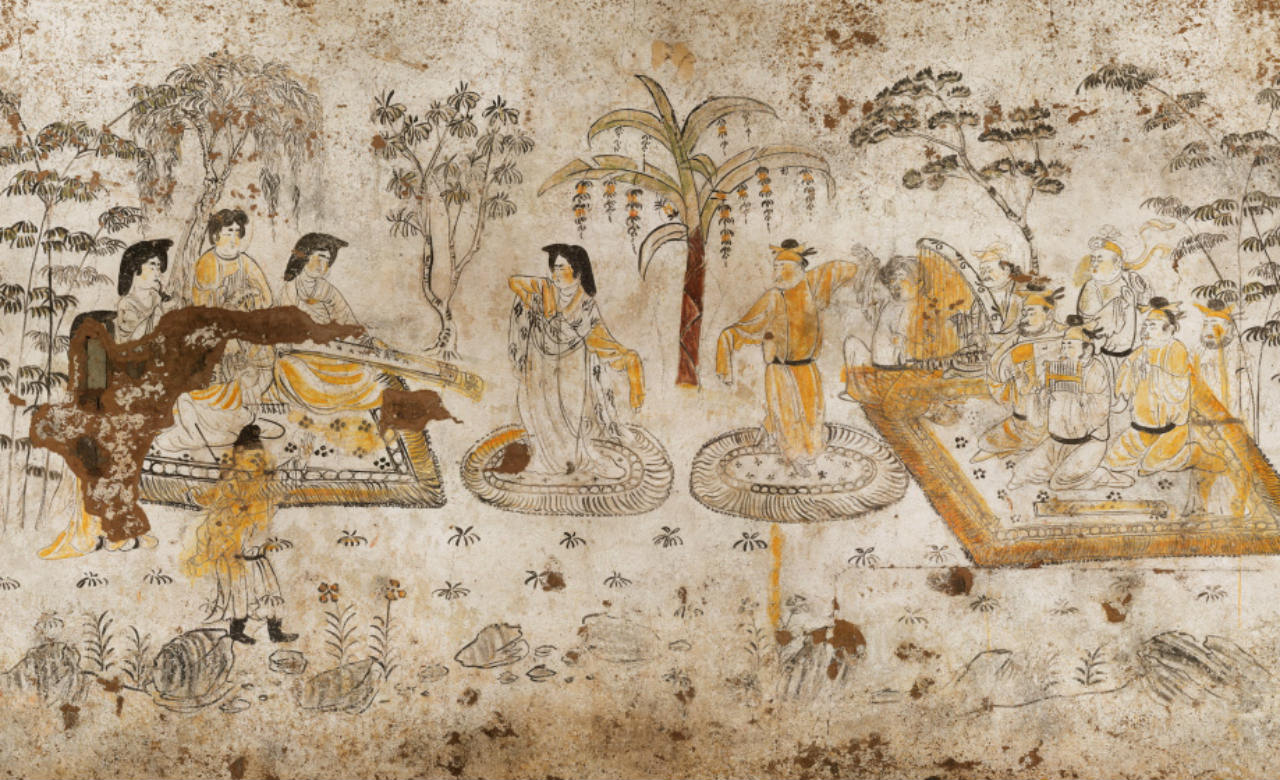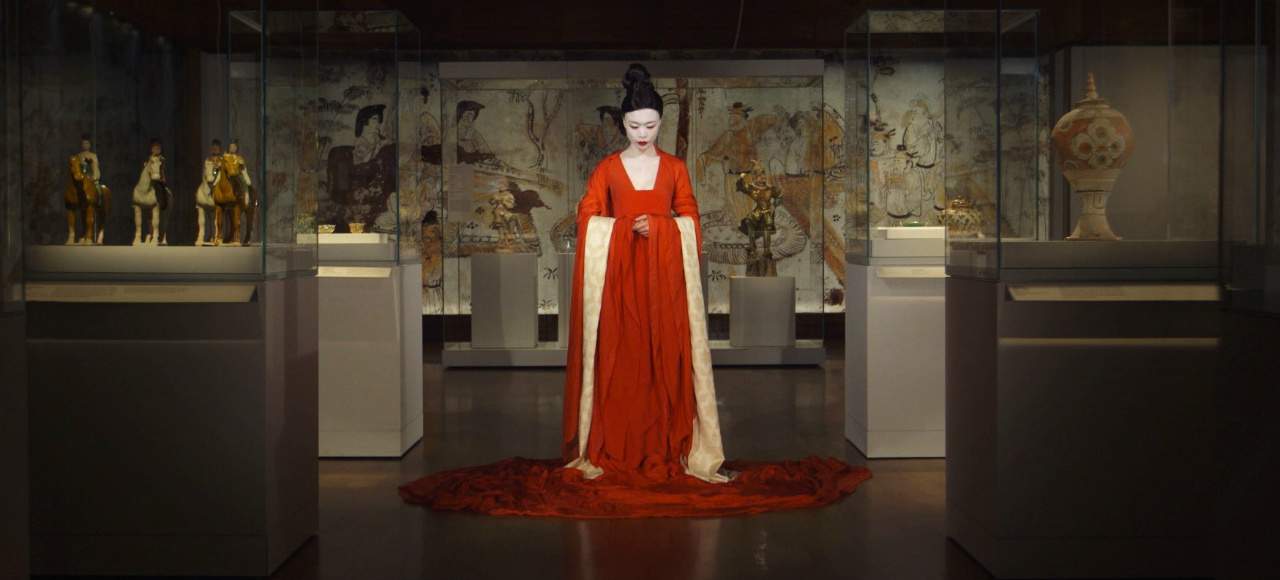Tang Style: Unpacking Fashion in the Golden Age of China
Fun fact: Emperor Wenzong's decreed sleeve limit was 2.65 metres (large enough to please a few Ellery fans out there).
in partnership with
The Art Gallery of NSW's current exhibition, Tang: treasures from the Silk Road capital, presents exquisite objects from a period (618-907 CE) seen by many as the golden age of Chinese culture. Sitting at the start (or, more to the point, the end) of the Silk Road trade route, which wound across the Asian continent all the way to modern day Turkey, the Tang capital Chang'an was a true cosmopolitan hub. Its residents had a particular taste for international haute couture and they had the coin and position to indulge it.
Tang China offered women unprecedented political and social freedoms: they could own property and divorce their husbands; and it was in this period that Wu Zetian reigned as Emperor (the only woman in China's history to have done so). The garments worn by Tang women reflect this shift in power dynamics, as women experimented with transgressive styles that shocked some contemporary observers. Tang gives us a glimpse of the incredible fashions that emerged in this context. Here are some highlights.

WHO WEARS THE PANTS?
Tang China was a period of unprecedented freedom for women of a certain class and the fashions of this period really reflect that. Traditional strict Confucian dress codes were flouted by some women who began to show off their arms, back and (the horror!) decolletage. But perhaps the biggest surprise is the fact that Tang women sometimes wore men's clothes, both foreign and Chinese in style. A mural in the exhibition actually shows one such badass woman wearing a white robe over striped trousers.

BROW DOWN
The period's extravagant hairstyles and makeup also reflect the wealth and splendour of Tang China. Many of the coifs depicted in Tang look like feats of engineering (bringing to mind the hairdos rocked by Marie Antoinette some centuries later), with hair arranged in tall sculptural shapes on top of the head. And when it comes to eyebrows, Tang China had it down to a fine art. Indeed Emperor Wenzong (who seems to have been quite the stick in the mud) decreed in the 9th century that women had to cease removing their eyebrows, a practice which made it easier to paint on intricate designs. The different styles of these painted eyebrows were given the most delightful names imaginable. As you walk through the exhibition try and look out for the "mandarin duck", "drooping pearl" or "dark fog" eyebrows.
IF YOU'VE GOT IT...
As is often the case, clothes were a means by which Tang elites could demonstrate their wealth and sophistication. There is no denying the grandeur of the clothes depicted in Tang, not to mention a particularly stunning jade pendant that is on display. Showing off through fashion was not without its risks however; one Tang princess was punished by Emperor Wenzong for wearing excessively long sleeves. Admittedly, the Emperor does seem to have been pretty generous, considering his decreed sleeve limit was 2.65 metres (large enough to please a few Ellery fans out there).
Various sumptuary laws were enacted throughout the Tang dynasty — Emperor Xuanzong for example actually ordered the burning of jade and pearl goods as a rejection of extravagant palace tastes. But you get the sense that the buzzkillers were fighting a losing battle. One Tang princess commissioned the imperial workshop to create her a skirt made of feathers. The skirt was such a hit that other elites copied the look, creating a huge trend for the feathers of exotic birds. Luxury items were a prominent feature of life in the Silk Road capital, and there was no shortage of new and more ostentatious goods to be consumed.

WHAT'S OUT IS IN
Thanks to the power of trade, the Tang dynasty China delighted in adopting fashions of both foreign cultures and Chinese ethnic minorities — what was literally outside the Tang dynasty found itself very in fashion during this time. Referred to as hufu, foreign dress was accessible in Tang China because of the influx of international goods, people and ideas into its capital. The AGNSW exhibition is peppered with gorgeous examples of this foreign influence — if you know where to look. Luckily, we have the exhibition's curator Yin Cao to guide us. What I had taken for a pair of soggy baguettes on the back of a ceramic pack horse figurine, are in fact bolts of the silk fabric that were China's most significant luxury export during in this period (it ain't called the Silk Road for nothing).
Men's fashion borrowed from external influences, with several earthenware figurines in the exhibition depicting horse riders wearing prints reminiscent of Persian patterns. Palace women also adopted foreign fashion while riding, and, to the chagrin of some contemporary writers, they abandoned traditional modest face veils in favour of hats made of felt, a nomad fabric. And while fashions come and go, fusty old men are eternal, as one Tang politician lamented, "Our women are acting like foreigners' wives, studying foreign makeup." The exotic fashions worn by the elite filtered down to the masses in what some feared was a sign of a 'corrupted empire'. Despite these concerns, men and women of Tang China continued to seek out new styles that came through the Silk Road, dressing themselves in clothes that could be Turkish, Tibetan, Persian or Uighur in style. Some of these clothes saw their wearers branded 'barbarians' by their more conservative compatriots, an indication of conflicting attitudes to China's unusual openness to other cultures in this period.
Tang: treasures from the Silk Road capital runs until July 10 at the AGNSW and there's more info right here.







